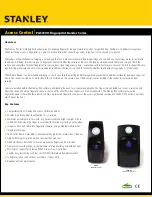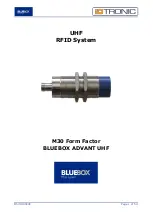
3
English
INTRODUCTION
All users must read these operating
instructions carefully prior to the initial
operation. These instructions are intended to
acquaint the user with the product and enable
him to use it to the full extent of its intended
capabilities. The operating instructions contain
important information on how to handle the
product in a safe, correct and economic way.
Acting in accordance with these instructions
helps to avoid dangers, reduce repair cost and
down time and to increase the reliability and
lifetime of the product. Apart from the
operating instructions and the accident
prevention act valid for the respective country
and area where the product is used, also the
commonly accepted regulations for safe and
professional work must be adhered to.
CORRECT OPERATION
- The unit is used for lifting, pulling and ten-
sioning of loads.
- The unit can also be used for lashing of loads
on trucks etc. please refer to the values for
hand and tensioning force “S” mentioned
on the name plate.
- The capacity indicated on the product is the
maximum safe working load (W L L) that may
be attached.
- The load and suspension hook of the hoist
during lifting operations, must be perpendi-
cular to the center of the load to prevent
pendle motion of the load (Fig. 1).
- Do not allow personnel to pass under a sus-
pended load.
GB
- After lifting or tensioning, a load must not
be left unattended for a longer period of time.
- Start moving the load only after it has been
attached correctly and all personnel are clear
of the danger zone.
- The operator must ensure that the load is
attached in a manner that does not expose
himself or other personnel to danger by the
hoist, chain(s) or the load.
- The hoists can be operated in ambient tem-
peratures between - 10
°
C and + 50
°
C.
Consult the manufacturer in case of extreme
working conditions.
Note:
At ambient temperatures below 0
°
C
the brake should be checked for freezing.
- The accident prevention act and/or safety
regulations of the respective country for using
manual hoists must be strictly adhered to.
- lf defects are found stop using the hoist
immediately.
INCORRECT OPERATION
- Do not exceed the rated capacity of the hoist.
- Do not extend the hand lever (Fig. 2).
- Welding on hook and load chain is strictly for-
bidden. The load chain must never be used
as ground connection during welding (Fig. 3).
- Avoid side pull, i. e. side load on either hous-
ing or bottom block (Fig. 4).
- It is forbidden to use this product for the
transportation of people (Fig. 5).
- The load chain must not be used for lashing
purposes (sling chain) (Fig. 6).
- Do not knot or shorten the load chain by
using bolts/screws/screwdrivers or other
devices (Fig. 7). Do not repair load chains
installed in the hoist.
- Do not remove the safety latch from the top
or bottom hooks.
- Never attach the load on the tip of the hook.
This also applies to the top hook (Fig. 8).
- Do not use the chain stop as an operational
limit device (Fig. 11).
- Turning of loads under normal operating
conditions is not allowed, as the bottom
blocks of the hoists are not designed for this
purpose. If turning of loads is required as
standard, the bottom blocks have to be pro-
vided with swivel hooks supported by axial
bearings. In case of queries consult the
manufacturer.
- Do not throw the hoist down. Always place it
properly on the ground.
- The device may not be used in potentially
explosive zones (special designs on request).
INSPECTION PRIOR TO INITIAL
OPERATION
Each unit must be inspected prior to initial
operation by a competent person. The inspec-
verschlungen ist. Bei zweistrangigen Geräten
kann es zu einer Verdrehung z.B. dann
kommen, wenn die Unterflasche umge-
schlagen wurde (Fig. 9).
Bei Kettenersatz ist auf richtigen Kettenverlauf
zu achten (Fig. 10). Außerdem muss die
Kettenschweißnaht nach außen zeigen.
FUNKTION / BETRIEB
Kettenfreischaltung
Schalthebel (Fig. 11) in Neutralstellung
bringen. Die Kette kann in beide Richtungen
gezogen und der Lastkettenstrang schnell auf
Vorspannung gebracht werden.
Achtung:
Die Mindestbelastung für das
automatische Schließen der Bremse liegt
zwischen min. 30 - 45 kg.
Heben der Last
Schalthebel in Richtung Heben ‚ ‘ stellen und
einrasten lassen (Fig. 11).
Mit Handhebel Pumpbewegungen ausführen.
Wenn das Hebezeug unter Last steht, ohne
dass damit gearbeitet wird, muss der Schalt-
hebel in Stellung Heben ‚ ‘ verbleiben.
Die Last stets in der Hakenmitte einhängen.
Hakenspitze nicht belasten (Fig. 8).
Senken der Last
Schalthebel in Richtung Senken ‚ ‘ stellen und
einrasten lassen (Fig. 11).
Mit Handhebel Pumpbewegungen ausführen.
Verspannung der Bremse
Wird ein unter Last stehendes Hebezeug durch
Abheben der Last bzw. Einreißarbeiten plötz-
lich entlastet, ohne das zuvor die Senkarbeit
eingeleitet wurde, so bleibt die Bremse ge-
schlossen. Ein Schließen der Bremse erfolgt
ebenfalls, wenn der Lasthaken mit der Unter-
flasche zu fest gegen das Gehäuse gezogen
wird.
Lösen der verspannten Bremse
Schalthebel in Richtung Senken , ‘ stellen und
Handhebel ruckartig durchdrücken. Falls die
Verspannung sehr hoch ist, kann die Bremse
mit einer schlagartigen Belastung auf den
Handhebel gelöst werden.
PRÜFUNG / WARTUNG
Die Prüfung ist mindestens einmal jährlich,
bei schweren Einsatzbedingungen in kürzeren
Abständen, durch einen Sachkundigen
vorzunehmen. Die Prüfungen sind im
Wesentlichen Sicht- und Funktionsprüfungen,
wobei der Zustand von Bauteilen hinsichtlich
Beschädigung, Verschleiß, Korrosion oder
sonstigen Veränderungen beurteilt sowie die
Vollständigkeit und Wirksamkeit der
Sicherheitseinrichtungen festgestellt werden
muss.
Reparaturen dürfen nur von Fachwerk-
stätten, die Orginal YALE Ersatzteile
verwenden, durchgeführt werden.
Die Prüfungen sind vom Betreiber zu
veranlassen.


































